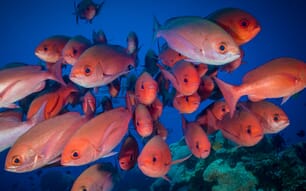Unlike other Bering Sea crab stocks, surveys on golden kings have been limited due to distance and high costs. The deep water stocks have sustained a fishery for 30 years, but managers aren’t sure about what’s really going on down there.
The golden crab catch has been limited with a conservative six million pound cap, and crabbers have long believed that the harvest could be higher - but the lack of research left too many questions about the overall abundance of the resource. Until now: an experiment by the crab fleet and researchers has revealed that golden king crab stocks around the Aleutian Islands are not only stable, they are thriving.
“The fleet has over the years changed the pot mesh size to allow little crabs to escape. That’s great fishing practice, but unfortunately, it is not great scientific information. Managers have been concerned as to whether there is any recruitment of small golden crab into the population,” said Denby Lloyd, science advisor for the Aleutian King Crab Research Foundation, formed by the harvesting vessels.
In the experiment, pots with small mesh designed to not let the little ones go, were put down next to strings of regular gear during the commercial fishery. (Golden king crab pots are strung together with long lines to prevent them from getting lost in the region’s massive underwater mountain ranges.) The results were very clear, Lloyd said.
“The regular pots caught good numbers of legal sized crab but not many sub legals. But the paired research pots right next to them caught as many or more legal crab and very large numbers of smaller crab,” he said.
Research will be ongoing and fishery managers will use the data in stock assessment modeling. The end result could be a new king of the crab hill.
“With this level of productivity,” Lloyd said, “potentially those quotas will increase for golden king crab, we might be in competition with Bristol Bay for Alaska’s largest king crab harvest.”
The Aleutian Island crab fleet also is helping with ocean acidification and handling studies. Lloyd had high praise for the collaboration: “Having the industry be this enthusiastic and having the agencies open up to immediate cooperative research opportunities like this, it’s really fun stuff."
Steller upticks - There is “strong evidence” that the numbers for both western and eastern populations of Alaska’s Steller sea lions appear to be, by and large, on an upward trajectory. That’s according to a May 15 technical memorandum by researchers at the (Seattle-based) Alaska Fisheries Science Center, which summarizes results of air and ship-based sea lion surveys from 2000 to 2012.
The upticks are good news. Since the late 1990’s many Alaska fisheries have been restricted in regions where numbers of sea lions have been dwindling for decades, notably, in Central Gulf and areas further west.
The AFSC memo said that while the western Aleutian stocks still appear uncertain, numbers increased in the eastern and western Gulf of Alaska, and the eastern Aleutians. If those counts continue to tick up through 2015, some Steller stocks could be on track toward a down listing from ‘endangered’ to ‘threatened’ status under the Endangered Species Act.
Conversely, in Southeast Alaska sea lion numbers remain on an increase, a trend since the 1970s. The surveys showed at least 1,600 sea lions moving from the central gulf to Southeast during breeding season, the memo said. www.afsc.noaa.gov
Frankenbreed - Studies from Canada show that genetically modified salmon can cross breed with a close relative: brown trout, and produce an even faster growing hybrid. Researchers at Memorial University of Newfoundland said the study highlights the ecological consequences should so called Frankenfish get into the wild.
Ronald Stotish of Aqua Bounty, the Massachusetts and Panama-based company creating the the GMO salmon, insists the risk of it breeding in the wild is ‘negligible.’
The application calls for land-based, contained cultivation of all sterile female populations that will be reared only in FDA inspected facilities,” he said.
The Food and Drug Administration will announce in a few months if it approves GMO salmon for human consumption. Congress is still debating whether the GMO fish will be labeled to alert American consumers.
Speaking of labels - should the government have a role in certifying sustainable seafood? The Marine Fisheries Advisory Committee (MAFAC), an advisor to the Secretary of Commerce, wants feedback “on the benefits and limitations of third party seafood certifications, and the potential for a federal government role.”
Having a fishery certified as being well managed for sustainability has become a necessary part of global seafood commerce. Find a link to the MAFAC survey at www.surveymonkey.com/s/TZZHNZB Questions? Contact Keith Rizzardi krizzardi@stu.edu




